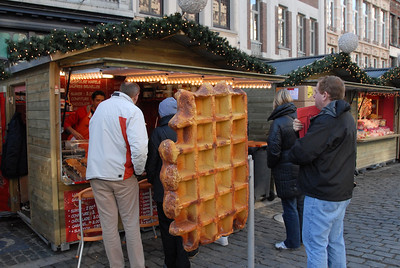
At a recent holiday party I got pulled into a conversation about why Belgium is such a fantastic country to visit. According to the Belgium buffs, it possesses everything that anyone could ever desire — quaint cities, beautiful architecture, first rate art, few tourists and loads of excellent food including Trappist beer, fries, mussels and chocolates.
While I wouldn’t rank Belgium as my top vacation spot, I do enjoy much that this historic land and the headquarters of the European Union has to offer. Of course, I love the aforementioned art and architecture. I likewise adore the world class chocolates and beer. What sells me on Belgium, though, is its waffles.
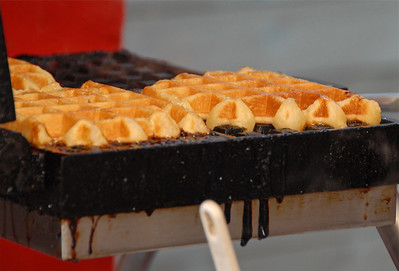
Sold throughout the country in cafes and on street corners, waffles are believed to be a spin-off of the medieval Flemish wafer. Like their small and crisp predecessor, these honeycombed cakes are cooked between two greased, patterned, metal plates.
Originally, folks pulled out their waffle irons only on special occasions. In fact, during the Middle Ages parents of a newborn girl would often receive an engraved one as a gift. It was expected that the daughter would take this press with her when she married and left home. Although still just as celebrated, today waffles irons are bestowed and waffles are consumed at any time or occasion.
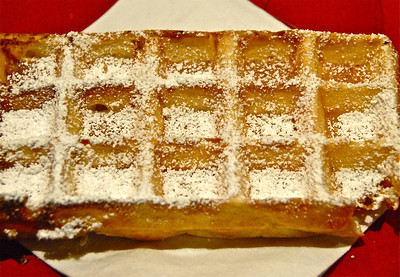
Belgium produces two distinct types of waffles — Brussels and Liege. Rectangular in shape and airy in texture, the Brussels version is what Americans refer to as a Belgian waffle. Unlike in America, where this waffle is drenched in maple syrup, in Belgium it gets dusted with a thin layer of confectioner’s sugar.
If given a choice, I make a beeline for Liege waffles. Hailing from the French-speaking city of Liege, these waffles are denser, sweeter and more filling than their Brussels counterpart. Chow down on one of these and you’ll feel as though you’ve consumed an entire meal. Truthfully, when I’m in Belgium, a warm and sugary Liege waffle often is my meal.
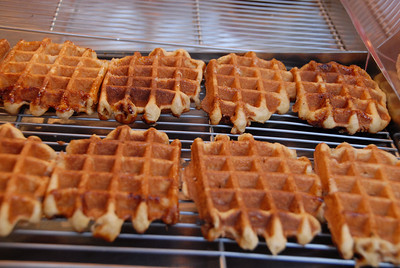
Liege waffles get their heartiness from their thick, brioche-like dough. The dough itself is studded with pearl sugar, which caramelizes as the waffle cooks. The result? One of the most divine sweets that I’ve ever eaten.
SUGAR WAFFLES FROM LIEGE
From Ruth Van Waerebeek’s Everybody Eats Well in Belgium Cookbook (Workman, 1996)
Makes 10 waffles.
Note: You’ll need to create two separate batters for these waffles.
For batter 1:
1 1/4 ounces fresh cake yeast or 2 1/2 packages active dry yeast
1/4 cup warm water
1 cup all-purpose flour
1 tablespoon granulated sugar
1 large egg, beaten
1/3 cup milk, warmed
For batter 2:
9 tablespoons unsalted butter, at room temperature
6 tablespoons all-purpose flour
1 teaspoon vanilla extract
1/4 teaspoon baking powder
1 teaspoon ground cinnamon, optional
Pinch of salt
1 tablespoon granulated sugar
1/2 cup pearl sugar or 3/4 cup crushed sugar cubes
To prepare batter 1, dissolve the yeast in a small bowl with warm water and 1 tablespoon flour and sugar. Let stand for 5 minutes until foamy.
Sift the remaining flour into a large mixing bowl. Make a well in the center and add the yeast mixture, egg and milk. Mix well with a wooden spoon to make a smooth batter. Cover with a kitchen towel and let rise in a warm place until the batter has doubled or tripled in volume.
Meanwhile, for batter 2, mix the butter, flour, salt, vanilla, baking powder, optional cinnamon, granulated sugar and pearl sugar into a paste.
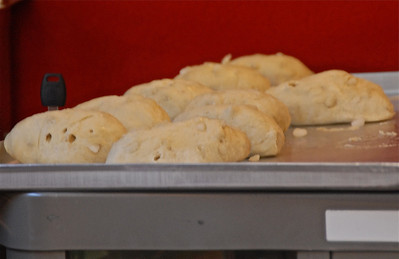
Using your hands, work batter 2 into batter 1 until well mixed. Shape the dough into 10 balls approximately 2 1/2 to 3 ounces each. Flatten each ball into a disk and dust lightly with flour.
Bake the disks in a medium-hot waffle iron. Don’t let the iron become too hot or the sugar will burn. Bake until the waffles are golden brown but still slightly soft, 3 to 4 minutes. Serve lukewarm or cooled to room temperature on a rack.